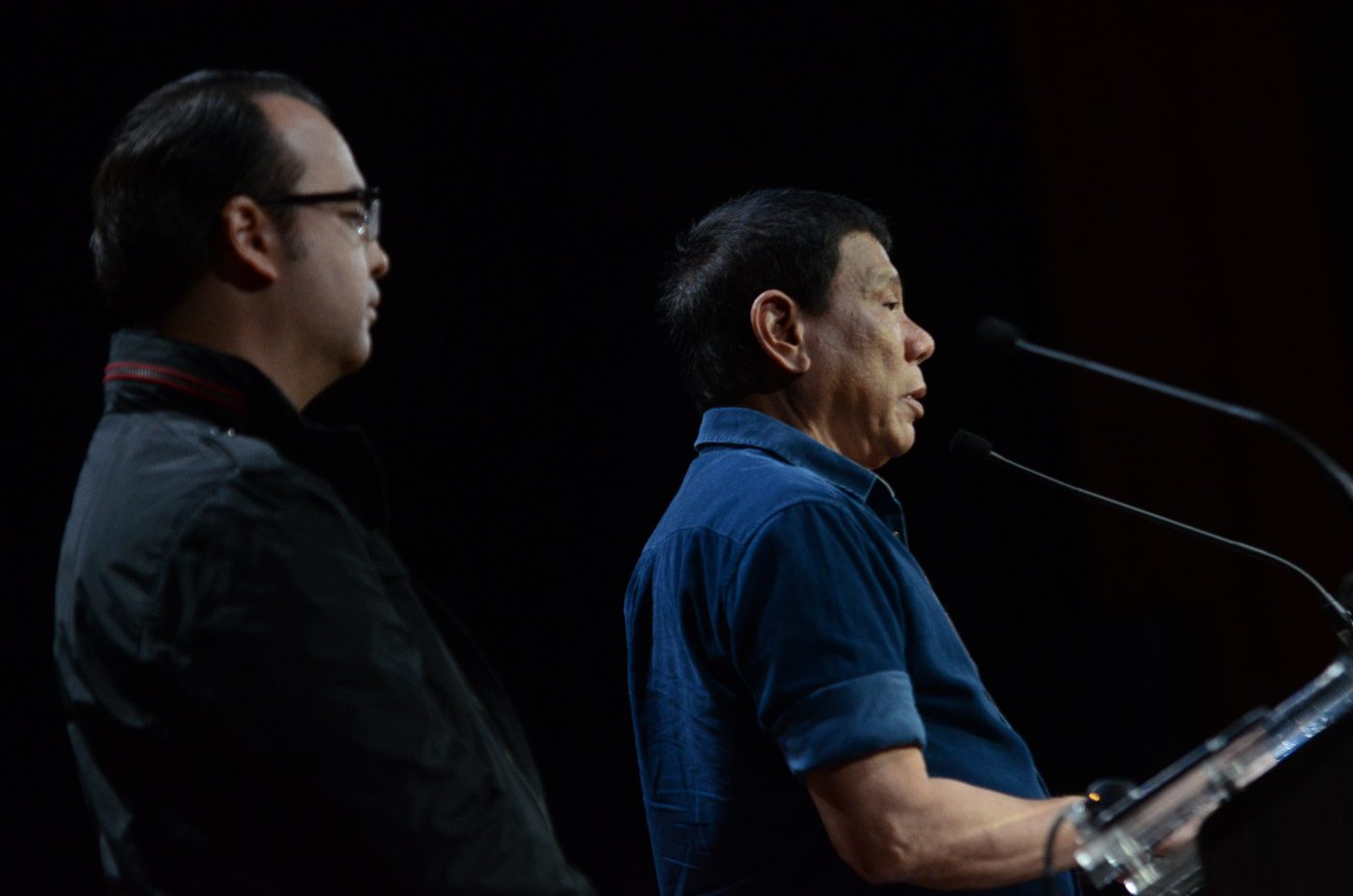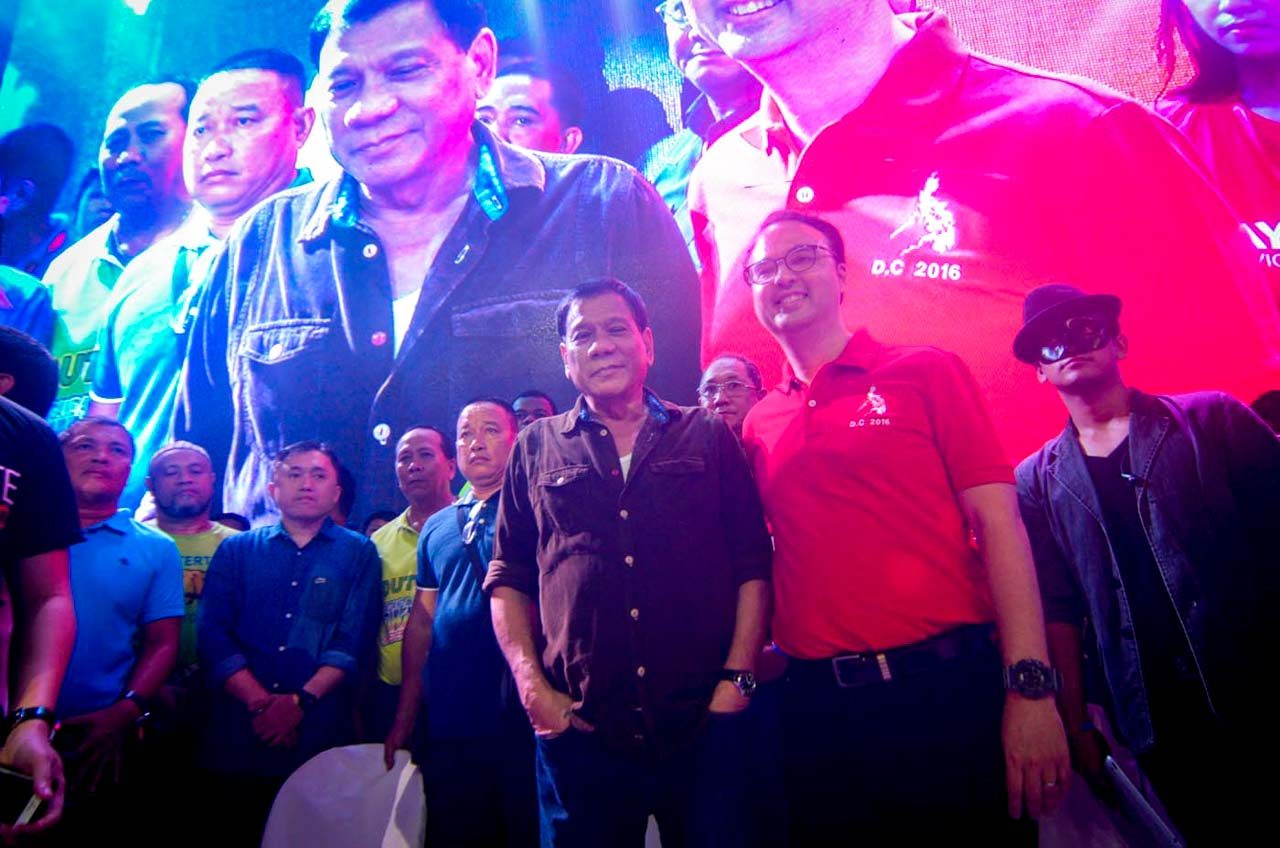SUMMARY
This is AI generated summarization, which may have errors. For context, always refer to the full article.

A study in contrast. That’s what Rodrigo Duterte and Alan Peter Cayetano are.
One is from Luzon, the other from distant Mindanao. One is a senator, the other a local mayor. One was intent on seeking a higher position, the other seemingly wishy-washy about running. One is for the Bangsamoro Basic Law (BBL), the other against it (although that seems to have changed recently). One is comfortable in designer shoes, the other in unbranded loafers sans socks. One is sacrilegious; the other said to be religious.
If there’s one thing they probably have in common, it’s irreverence, or maybe, a fighting demeanor.
Before they formalized their team as one aiming for the presidency-vice presidency (VP) posts in May 2016, one camp was looking the other way. Some Duterte supporters said it was more strategic to team up with vice president wannabe Senator Ferdinand “Bongbong” Marcos Jr whose name still has strong drawing power in the north.
Some Marcos supporters also wanted Duterte because of the strongman appeal. Yet the same reasoning appealed to some Cayetano supporters, too, who believed that the contradictions between the two men were precisely what would make the tandem work.
In the end, after all the hemming and hawing and the wooing and naying, it was Cayetano who emerged the most persistent and patient. Though torn between two VP choices, the strongman from the south was left with the senator from the south of Manila. Duterte’s team, even in their choice of VP bet for their candidate, was unconventional: “matira matibay (strong man standing).”
Though a pair, the two gentlemen were separate. They filed their certificates of candidacy separately at the Commission on Elections, with voters unsure up until the last few days that Duterte would run for president.
When he filed his COC on October 16 without the Davao mayor, Cayetano said he remained “hopeful” Duterte would too. It was not until November 27, however, when Duterte filed his candidacy for president, through a representative, at the poll body. Two days later, the deal between Rody Duterte and Alan Peter Cayetano was sealed.
At a concert in the city of Taguig, bailiwick of Cayetano, the two candidates finally made an appearance together before their Metro Manila audience. Making known his final choice for vice president, Duterte declared, “Alan Peter Cayetano. Committed na ako. Isang salita lang ako.” (I am committed. I have one word.)

They sat side by side then stood shoulder to shoulder in front of a supportive crowd whose stamina and patience got a boost till the wee hours from bands, celebrities, and stand-up comics. The “DC tandem”, awkward as it seemed, was officially born.
The whisperer
Fast forward to the Rappler forum on #TheLeaderIWant last week. Observers noticed that the two entered the huge hall at De La Salle University separately, again. Duterte first and then Cayetano. Even prior to the event itself, the two were not conversing as partners normally would in preparation for a major forum, at the very least to coordinate responses and exchange quick notes.
They came together only on stage when Cayetano stood to the right of his presidential candidate who spoke in a roundabout manner about what he would do as president. He rambled for close to 20 minutes.
When his turn finally came, Cayetano picked up and elaborated in a more organized and structured manner what his principal said about their platform. No extrajudicial killings, only killings when there is resistance to arrest. Federalism to disperse development more equitably. Equality under the law.
He continued that if Davao – which is triple the size of Metro Manila is Exhibit A – Taguig, his own city, is Exhibit B. “There is no fear in Davao, there is love, there is respect, there is pride,” he added, extolling the achievements of his running mate.
Cayetano pushed for his candidate, narrating how he decided to cast his lot with Duterte. He recalled telling Duterte when he had not yet made clear his decision to run for president, “Mayor, kung tatakbo ka, sa ’yong sa ’yo na kami (Mayor, if you’re running, we are all yours).”
He ended his spiel with: “I urge you, support his man, give him 6 months, he will not disappoint you.”
For the most part of the forum, the two fielded questions that ranged from ISIS to congestion in the metro, to slow Internet, drugs, peace and order, and yes, the BBL. Many observed how Cayetano continued to play the role of explainer, some even calling him the “Duterte whisperer”.
Perceived as ambitious and predisposed to being confrontational in the Senate, the 45-year-old Cayetano beside the 70-year-old Duterte is more deferential, almost careful to show he does not mind being upstaged by the cussing, irreverent, sometimes uncouth mayor.
Offstage, there is a level of discomfort between the two men and their respective staff. After all, they do not belong to the same political party and had not been together in previous campaigns.
Separate ways
Philippine election results are replete with examples of winning pairs that didn’t really see eye to eye. When Cory Aquino became president in 1986, there was a lot of distrust for her vice president, Salvador “Doy” Laurel. Fidel V. Ramos of Lakas-NUCD won in 1992 but his running mate Lito Osmeña, former governor of Cebu, lost to actor Joseph Estrada, then under the Nationalist People’s Coalition.
In 1998, Estrada, who had his own Laban ng Makabayang Masang Pilipino won as president, but his partner, then senator Edgardo Angara of Laban ng Demokratikong Pilipino, lost to Gloria Macapagal-Arroyo who was then with Lakas.
In 2004, three years after the ouster of Estrada, the economist Arroyo ran for president and won with broadcaster Noli de Castro as her vice president. De Castro, who ran as independent, eventually allied himself with Lakas.
In 2010, the Liberal Party’s Benigno “Noynoy” Aquino III won as president but his running mate Mar Roxas lost to Jejomar Binay of PDP-Laban. Holding disparate views and values, Binay was left out by the administration party.
Of the other president-VP teams for 2016, it is only Roxas and Leni Robredo (Liberal Party), and Binay and Gregorio “Gringo” Honasan (United Nationalist Alliance) who share the same party. The rest are an assemblage of candidates brought together by political convenience or convergent interests.
For the DC tandem, Cayetano is Nacionalista, while Duterte is with the more left-leaning PDP-Laban. On the campaign trail, will they grow into each other more? Will Cayetano remain the explainer and the whisperer? Assuming they both win, will Duterte-Cayetano be able to do better than their predecessors?
After the ouster of dictator Ferdinand Marcos, we’ve seen 3 presidents with vice presidents they were uncomfortable with, and whose plans and priorities, even positions on key issues, did not necessarily jibe with their own. Having to choose individual candidates (even if they belonged to opposing parties), rather than political parties, has left us with disjointed programs of government and a great deal of discontinuity.
Perhaps it’s about time we choose our leaders on the basis of how well they can work together, and how well they agree on where to take us. – Rappler.com
“The Scrum” is Rappler’s take on issues and personalities of the 2016 elections. Derived from a media term that refers to reporters surrounding politicians to press them to answer questions and respond candidly, “The Scrum” hopes to spark smart conversations on politics and election.
Add a comment
How does this make you feel?
There are no comments yet. Add your comment to start the conversation.